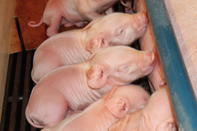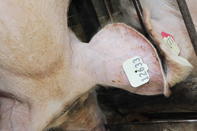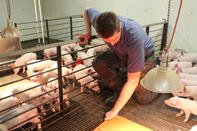
Weaning of Piglets
To ensure better production, the first month after weaning piglets is critical and should receive careful attention. Even at a weaning age of 6 weeks, the piglet is being deprived of the benefits of family comforts at a much earlier age than when weaned by the sow herself. The reason for weaning ‘early’ is to give the sow some recovery time before sending her back to the boar, which she will readily do. A sow is expected to produce at least two litters per year, but will often need at least one cycle of three weeks to regain condition. The weaning age is not strictly set and there is some benefit in ‘split-weaning’. This means taking some of the stronger sucklers to the weaner house a week sooner than the others. Because of less competition, smaller piglets now get the chance to increase their milk intake. The weaning procedure is stressful for piglets in a number of ways: Piglets are deprived of the rich and copious supply of sow milk, available at hourly intervals when the sow lets down her milk. They will have to get used to new surroundings, smells, feed containers and noises. Piglets might be mixed with other weaners and may have to establish dominance through battles. If piglets of different ages are mixed, there will be new sources of infections and parasites, challenging the immune systems of the previously unexposed younger group piglets.Procedures at Weaning

Routine procedures at weaning may also include vaccination and mange treatment by injection. Tail and eyeteeth clipping are not necessary but an iron injection should be given in the first week of life.
Care of Weaners

Because the growth pattern and potential carcass value are determined at this age, it is vital that weaners should receive the best feed possible.
Every miller or co-op will have a weaner ration with 18% to 20% protein, in meal or pellet form. It will be expensive but the small-herd pig farmer’s best investment.
Care of Growers
This term has replaced the old term ‘fatteners’ in English and is used for the young pigs coming out of the weaner section at about 10 to 12 weeks old.Growers are the least demanding of the age groups. Their business is to eat as much as the farmer can give them, provided it is not spoilt with dirt, mould or plastic. A 16% protein grower ration should form the basis of grower pig’s feed program. Some savings can be made by supplementing the grower’s diet with regular supplies from supermarkets, dairies, canteens and vegetable wholesalers. This excess old food can be used to extend the balanced diet without over-doing the carbohydrates. Do not feed too much carbohydrate. Some millers will supply a supplement as an additional special additive.
Because pigs will eat almost anything, it does not mean they should be given rubbish to eat. The better the food, the better the growth rate and the carcass grading.